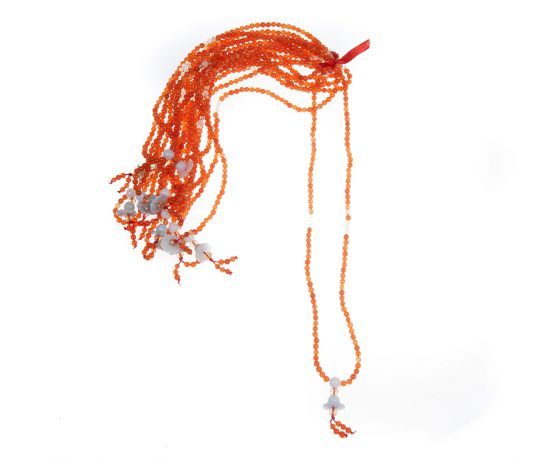We use cookies to make your experience better.
Mala made of carnelian and Burmese Jade
- Buy 10 for €9.90 each and save 24%
Carnelian is a red meat to brown, translucent to opaque chalcedoonvariëteit. It belongs to the quartz. Hetelement that the red color caused, is iron in which small impurities is in the mineral. By heating can deepen the color. Carnelian is named after the Latin carnis, which means "flesh." The old Dutch name is carnelian. Carnelian was already before the beginning of our era, used for the manufacture of seal stones and jewelery. They claimed carnelian offered protection against strife, toothache and nervous disorders, bleeding stilt, lowers fever, reduces anger and brings happiness. Carnelian occurs in volcanic and weathering zones and is known from India, Saudi Arabia and Egypt. Important sites are located in Brazil, the United States, Australia, Russia, Czech Republic, Germany and Romania.
A japa mala or mala, literally garland, is a prayer string of beads within Hinduism, with a similar function of the rosary in Christianity. The japa mala usually consists of 108 beads, although other numbers that are divisible by 9 are also used. Malas are used not to lose count when reciting, chanting or mentally repeating a mantra or name of a deity. A Buddhist prayer line (mālā, japamālā) is a prayer string of beads used in Buddhism. It has a similar function of the rosary in Christianity. The prayer cords are not used to lose the count when reciting or chanting. A Buddhist prayer string consists of 108 beads where a mantra must be prayed and 4 beads or 1 bead representing the four heavenly kings. A Buddhist prayer string is called Juzu in Japanese, in standard mandarin fozhu or shuzhu, and in Burmese a ba-di. A prayer string is a beaded necklace that is used to recite prayers. Well-known examples of such religious objects are the rosary in the Roman Catholic Church, the tsjotki / komboschkini in the Orthodox Church, the tasbih in Islam and the japa mala in Hinduism. A mala is a prayer line, which is mainly used by people with a Buddhist background. Nowadays you see that more and more people in the West buy a mala and use it as a prayer necklace or wear it as a necklace or bracelet.
The Tibetans use this cord to pronounce the most famous mantra (short prayer, sacred verse or magic formula) in particular. Who does not know the mantra: AUM MANI PADME HUM or as the Tibetans say: OM MANI PÈME HUNG or OM MANI BÈH MEH HUNG. ("Greeting to the pearl in the lotus of my heart.") Many other short mantras are prayed for all kinds of purposes. If we consider that there is a rosary in the Catholic faith, then it actually has the same function: It is a prayer line in which a number of prayers (our Father, Hail Marys) aloud or in, for and by yourself already mumbling in the church or sometimes before bedtime. A Mala usually consists of 108 prayer beads, but also of 54 (half) or 27 (a quarter) beads. The 109th bead (or the 55th or 28th) is called the Sumeru or Mera that symbolizes the crown chakra. This Sumeru may not be used as a prayer bead but is a turning point, starting point or end point of the mala. The first bead is always the bead to the left of the Sumeru and the last bead the bead to the right of the Sumeru.
The mala is handled in the right hand in such a way that the little finger and index finger in no way touch the bead or cord. So only the middle finger and ring finger are moved over the bead with the thumb at the bottom. If you come to the Sumeru and you want to recite a series of 108, 54 or 27 mantras for a second time, the mala is turned half a turn so that you continue clockwise and you do not go back to the left. The last bead is then the first bead. If you intend to pray the mala several times (JAPA = litany, repetition of prayers, spells and goddess names), you can put the necessary number for you on the table with the help of, for example, loose minerals or the like. to push aside, so that one does not let the thoughts be distracted by keeping the count. There are even more tools to focus your thoughts entirely on the mala and not on keeping the count.
You can see a lot of mala's (108 beads) or sumirdi (27 or 54 beads) with different types of beads. Known are the mala's of seeds of the Rudraksha tree and of the Lotus flower. You can also see mala's of rose sand or tulsi wood, but also of conch shells. The more expensive Malas are made of crystals or silver beads or pearls.












